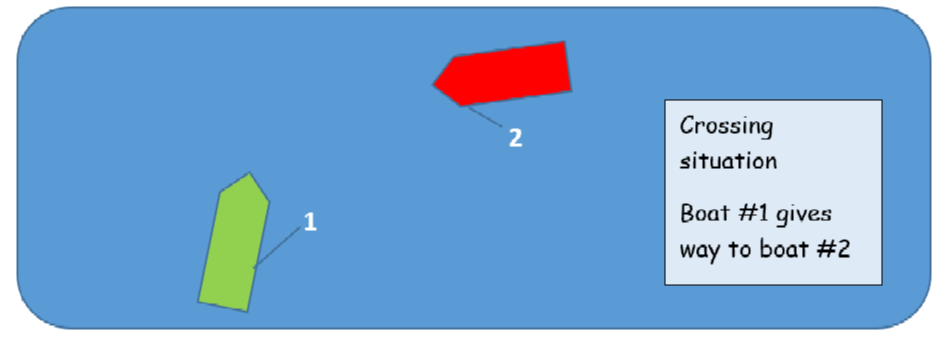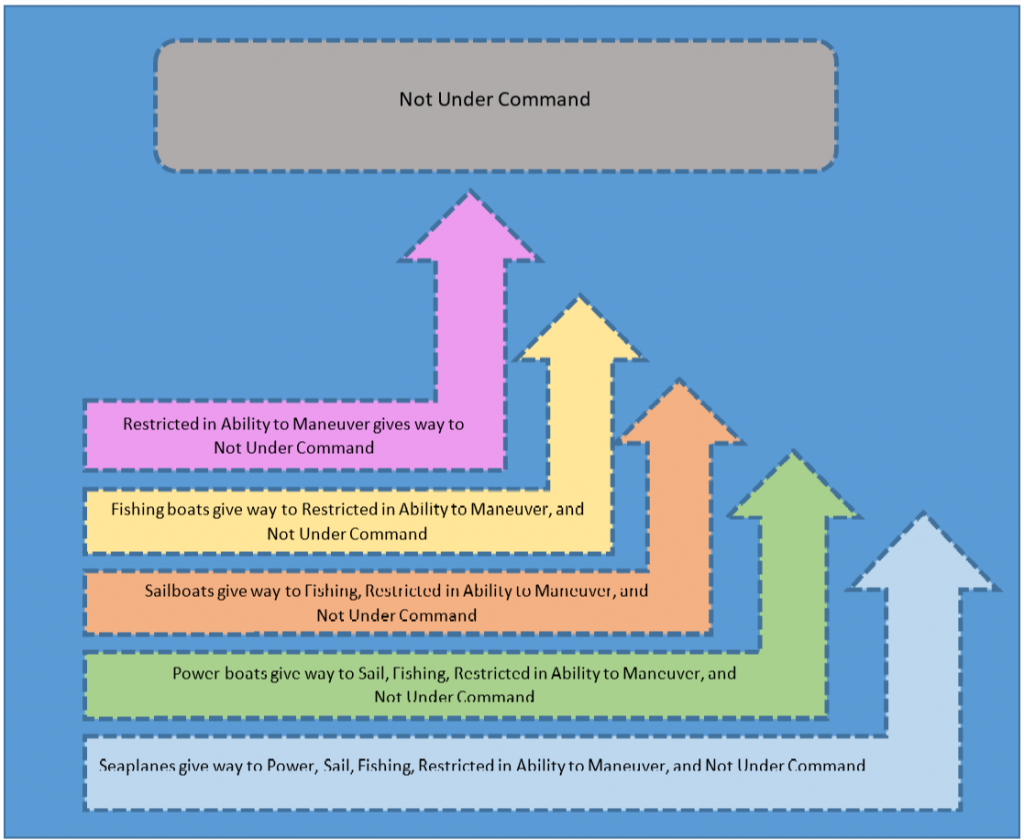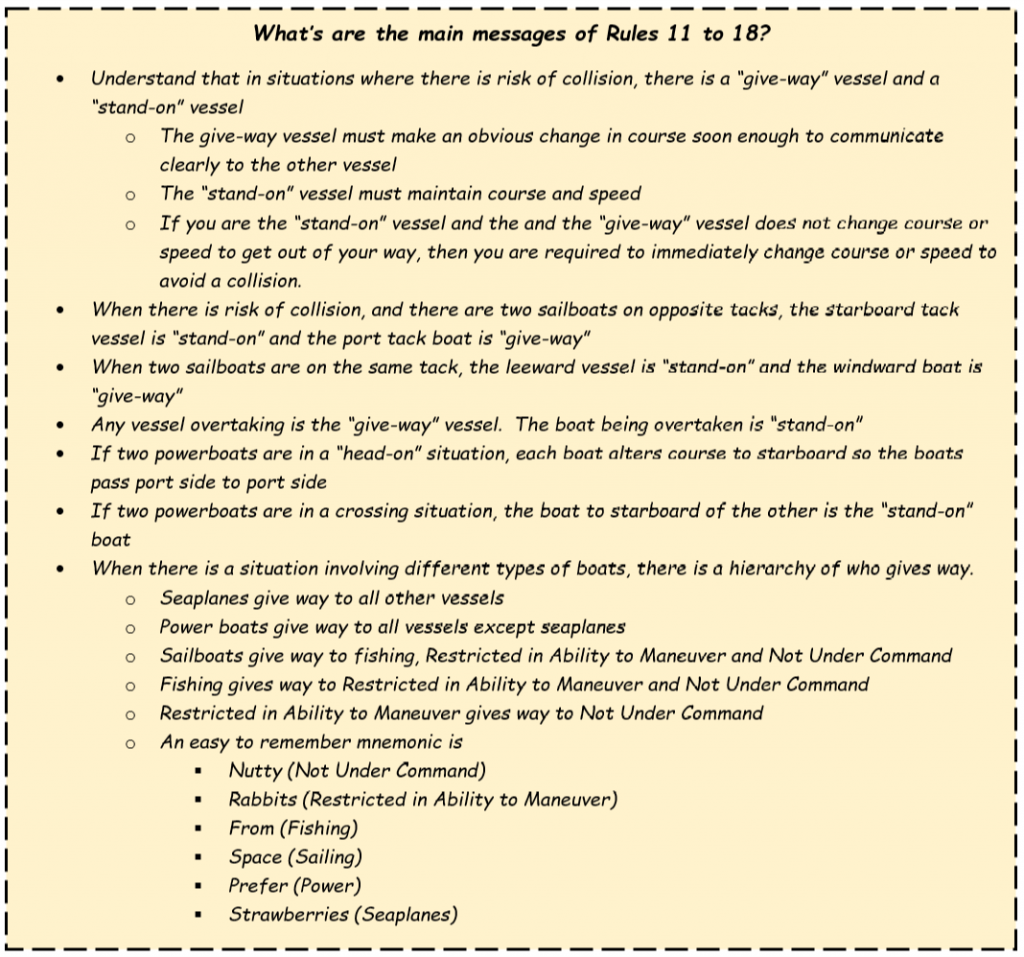Inland Navigation Rules
Nav Rules Made Easy
Rules 11 to 18
In the Nav Rules Made Easy series, we’ll explain each Inland Navigation Rule, with an emphasis on the information that’s most important for recreational sailing in the San Francisco Bay. We won’t include portions of the rules that are highly technical and intended for commercial mariners.
Note: If you travel more than one mile outside the Golden Gate Bridge or if you charter a boat in another country, the International Rules apply. Many of the International Rules are exactly the same as the Inland Rules. However, there are also a few that contain important and significant differences from Inland. Make sure that you study and learn International Rules if you are traveling in international waters.
This is just a simplified summary of the rules. To get detailed information, please refer to the
Navigation Rules and Regulations Handbook from Department of Homeland Security, United States Coast Guard.
Rule 11 – Application
Rules 12 to 18 apply when boats on the water are able to see each other.
Rule 12 – Sailing vessels
When two sailboats are at risk of collision, there are rules to clarify which boat gives way.
- If one sailboat is on starboard tack and the other one is on port tack, the port tack boat gives way to the boat on starboard tack.
The boat with the wind on the starboard side is the “stand on” vessel. The boat with the wind on the port side must stay out of the way of the starboard tack boat.
- If two sailboats are both on the same tack (does not matter whether that is starboard or port), the upwind boat gives way to the boat downwind. The upwind boat is called the “windward” vessel, and the downwind boat is the “leeward” vessel.
- If you are sailing on port tack and can’t figure out if the other boat is on port or starboard tack, assume they are on starboard tack and stay out of the way.
- A sailboat is on starboard tack when the mainsail is on the port side. The boat is on port tack when the main is on the starboard side.
Rule 13 – Overtaking
If you are overtaking or passing another boat, you must stay clear of the boat being overtaken. Your boat is the “give-way” boat, and the overtaken boat is the “stand-on” boat.
If you are under sail and overtake a power boat, you are the “give-way” vessel, and the power boat is the “stand-on” vessel.
If you’re not sure whether you are overtaking another boat, assume that you are overtaking and give way to the other boat.
Continue to give way until you are well past the other boat.
Rule 14 – Head-on situation
This rule applies to power boats.
Note: If you are on a sailboat using engine power, you are a power boat.
If two power boats are on course to meet head-on, each boat alters course to starboard so that the boats pass port side to port side.
If you’re not sure if you’re going to meet head-on, assume that you will be meeting and alter course to starboard.
Rule 15 – Crossing situation
This rule applies to power boats.
When two power boats are crossing and there is risk of collision, the boat on the port side gives way to the boat on the starboard side. The boat on the starboard side is the stand-on vessel.
The give-way boat should not cross in front of the stand-on boat.
Rule 16 – Action by give-way vessel
When your boat is the “give-way” vessel, you are required to change course or speed to avoid a collision.
Make course changes obvious enough so the other vessel can clearly see that you are altering course to avoid them, and soon enough to avoid the other boat’s skipper getting nervous.
Rule 17 – Action by stand-on vessel
When your boat is the “stand-on” vessel, maintain your course and speed. By maintaining your course and speed, you become predictable for the “give-way” vessel. The give-way vessel moves to get out of the way based on your position.
If you are the “stand-on” vessel and the “give-way” vessel does not change course or speed to get out of your way, then you immediately change course or speed to avoid a collision.
Rule 18 – Responsibilities between vessels
The navigation rules provides a clearly defined structure to follow regarding the various types of vessels and who gives way. In this structure, it’s important to understand the meaning of “Vessels Restricted in their Ability to Maneuver”. This is a technical definition. It means that the boat is actively engaged in work that results in limited maneuverability. Here are a few examples:
- A buoy tender working on a buoy
- A pilot boat transferring a pilot to another vessel
- A boat towing another boat and the tow arrangement makes maneuverability difficult
It is also important to understand the term: “Vessel Not Under Command”. A vessel not under command is a boat or water craft that can’t be steered and cannot get out of the way of another boat.
Hierarchy of vessels:
On open water when vessels can see each other, and there is not an “overtaking” situation, here is the order we follow:
- Seaplanes give way to all other vessels
- Power driven boats give way to all vessels except seaplanes
- Sailboats give way to
- Fishing boat actively fishing with lines and nets out
- Vessels restricted in their ability to maneuver
- Vessels not under command
- Fishing boats actively fishing give way to
- Vessels restricted in their ability to maneuver
- Vessels not under command
- Vessels restricted in their ability to maneuver give way to
- Vessels not under command
To help understand the arrangement of who gives way to whom, please review this diagram:
The “hierarchy of vessels” is an important concept to master if you’re going to be out on the water.
Here it is again in a more simplified version:
Not Under Command
Restricted in Ability to Maneuver
Fishing
Sailing
Power
Seaplanes
Here’s a mnemonic to help you remember the order of vessels:
| Nutty | Not Under Command |
| Rabbits | Restricted in Ability to Maneuver |
| From | Fishing |
| Space | Sailing |
| Prefer | Power |
| Strawberries | Seaplanes |





All of this is correct, but it does not address the two most common sources of confusion I see in my students:
1) There is never a case where two rules apply and are in conflict with one another. I often hear something like “He’s on port, but he’s leeward.” You should assess the right-of-way between sailboats in this order: Overtaking, Tack, and Leeward. A memory aid is “Out To Lunch” which is what you are if you don’t understand this 🙂 Is it an overtaking situation? The boat ahead has right of way. No need to consider tack or who’s to leeward. If it is not an overtaking situation, are the boats on the opposite tack? The starboard tack boat has the right of way. No need to consider who’s to leeward. Only if neither the overtaking nor the opposite tack rules apply do you need to consider the leeward rule.
2) The “rule of tonnage” and “commercial vs. recreational.” Neither of these concepts appear in the Colregs. If a power boat is not restricted in its ability to maneuver, and is not at anchor, and doesn’t fall into the categories mentioned by Matt above, then it is merely a power boat. It doesn’t matter how big it is, or whether it is a commercial vessel or not. Therefore, at sea, a 1000-ft. tanker must yield to a 30-ft. sailing vessel. This rule rarely needs to be brought to bear because vessels can see each other from a great distance when offshore. But it does, nevertheless, apply, just as the rules state. Closer to home, a tug that is not engaged in work with a barge or large vessel also falls under the category of ships that, as power boats, must yield to a sailboat. The same applies to a ferries when not restricted by being in their channel.
It easy to see why this must be so. If the “rule of tonnage” applied, how could you tell which ship is larger? Of course, your boat is smaller than a ferry, but what about two ferries crossing? How could one determine the tonnage of the other? The same is true of commercial vs. recreational. When we are teaching, is our vessel a “commercial” vessel? How would someone know that? There are many charter sailboats taking people on day sails on the Bay. How do you tell these from other sailboats? The Colregs, which were not composed casually, very wisely do not take these to things into account because they would cause confusion and therefore diminish, not increase, the safety of mariners.
So you might say, well, that’s OK, I’m still going to avoid big boats like ferries and tugs. That’s fine, but only at a distance. If you really are in a right-of-way situation, the ferry driver and the tug driver will expect you to obey the rules. It is silly to imagine they don’t know them; they have gone through extensive training and testing to hold their jobs. “But I’ll just stay out of their way.” Well, what they expect you to do as a sailboat is hold your course because that is what the rules require. Since they are going much faster, you are not the only vessel they will have concern themselves with. They will often see four or five vessels who may intersect them. They have already visualized how they will treat each crossing. But now a sailboat decides to change course even though the rules require that she stand on. Do you think that makes his day go more smoothly?
The Rules of the Road are not rules of etiquette which you follow to be polite. They carry the force of law and you should no more violate them than drive on the wrong side of the street. As with traffic laws, ignorance is not a defense.